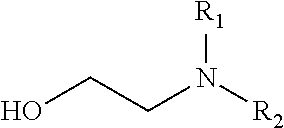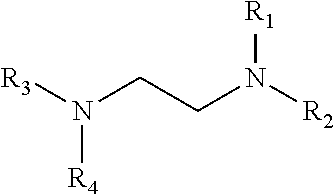Reaction of glycoladehyde
- Summary
- Abstract
- Description
- Claims
- Application Information
AI Technical Summary
Benefits of technology
Problems solved by technology
Method used
Image
Examples
example 1-6
[0140]An electrically heated 50 ml autoclave (Hastelloy) with a mechanical magnet-coupled stirrer was charged with 0.5 g of commercial dimeric glycolaldehyde in the particular organic solvent (15 ml) and 200 μl triethylene glycol dimethyl ether as internal standard. Subsequently, the amount of the catalyst specified in Table 1 was added. Next, dimethylamine, according to the molar ratio specified in Table 1 (dimethylamine:monomeric glycolaldehyde), was metered in and the mixture was pressurized to 70 bar of hydrogen and heated to 100° C. Stirring was effected at 100° C. and the particular pressure for 1 h. The reaction output was filtered off from the catalyst after 1 h and analyzed by GC (carbon percent, meaning the amount of substrate carbon atoms that can be detected as end products, with the internal standard as a reference) The conversion is 100% and the difference from 100% mass balance is unidentified secondary components.
example 7-11
[0143]An electrically heated 50 ml autoclave (Hastelloy) with a mechanical magnet-coupled stirrer was charged with 1 g of commercial dimeric glycolaldehyde in the particular organic solvent (25 ml) and 400 μl triethylene glycol dimethyl ether as internal standard. Subsequently, the amount of the catalyst specified in Table 2 was added. Next, ammonia, according to the molar ratio specified in Table 2 (ammonia:monomeric glycolaldehyde), was metered in and the mixture was pressurized to 70 bar of hydrogen and heated to 100° C. Stirring was effected at 100° C. and the particular pressure for 1 h. The reaction output was filtered off from the catalyst after 1 h and analyzed by GC (carbon percent, meaning the amount of substrate carbon atoms that can be detected as end products, with the internal standard as a reference) The conversion is 100% and the difference from 100% mass balance is unidentified secondary components.
example 12-15
[0146]An electrically heated 50 ml autoclave (Hastelloy) with a mechanical magnet-coupled stirrer was charged with 1 g of commercial dimeric glycolaldehyde in the particular organic solvent (25 ml) and 200 μl triethylene glycol dimethyl ether as internal standard. Subsequently, the amount of the catalyst specified in Table 3 was added. Next, monomethylamine, according to the molar ratio specified in Table 3 (monomethylamine:monomeric glycolaldehyde), was metered in and the mixture was pressurized to 70 bar of hydrogen and heated to 100° C. Stirring was effected at 100° C. and the particular pressure for 1 h. The reaction output was filtered off from the catalyst after 1 h and analyzed by GC (carbon percent, meaning the amount of substrate carbon atoms that can be detected as end products, with the internal standard as a reference) The conversion is 100% and the difference from 100% mass balance is unidentified secondary components.
PUM
| Property | Measurement | Unit |
|---|---|---|
| Temperature | aaaaa | aaaaa |
| Pressure | aaaaa | aaaaa |
| Temperature | aaaaa | aaaaa |
Abstract
Description
Claims
Application Information
 Login to View More
Login to View More - R&D
- Intellectual Property
- Life Sciences
- Materials
- Tech Scout
- Unparalleled Data Quality
- Higher Quality Content
- 60% Fewer Hallucinations
Browse by: Latest US Patents, China's latest patents, Technical Efficacy Thesaurus, Application Domain, Technology Topic, Popular Technical Reports.
© 2025 PatSnap. All rights reserved.Legal|Privacy policy|Modern Slavery Act Transparency Statement|Sitemap|About US| Contact US: help@patsnap.com



